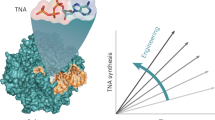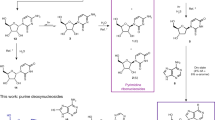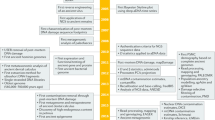Molecular breeding of polymerases for amplification of ancient DNA (original) (raw)
- Letter
- Published: 15 July 2007
- Michael Hofreiter2,
- Alexandra Vaisman3,
- David Loakes1,
- Didier Gasparutto4,
- Jean Cadet4,
- Roger Woodgate3,
- Svante Pääbo2 &
- …
- Philipp Holliger1
Nature Biotechnology volume 25, pages 939–943 (2007)Cite this article
- 2079 Accesses
- 101 Citations
- 10 Altmetric
- Metrics details
Abstract
In the absence of repair, lesions accumulate in DNA. Thus, DNA persisting in specimens of paleontological, archaeological or forensic interest is inevitably damaged1. We describe a strategy for the recovery of genetic information from damaged DNA. By molecular breeding2 of polymerase genes from the genus Thermus (Taq (Thermus aquaticus), Tth (Thermus thermophilus) and Tfl (Thermus flavus)) and compartmentalized self-replication3,4 selection, we have evolved polymerases that can extend single, double and even quadruple mismatches, process non-canonical primer-template duplexes and bypass lesions found in ancient DNA, such as hydantoins and abasic sites. Applied to the PCR amplification of 47,000–60,000-year-old cave bear DNA, these outperformed Taq DNA polymerase by up to 150% and yielded amplification products at sample dilutions at which Taq did not. Our results demonstrate that engineered polymerases can expand the recovery of genetic information from Pleistocene specimens and may benefit genetic analysis in paleontology, archeology and forensic medicine.
This is a preview of subscription content, access via your institution
Access options
Subscribe to this journal
Receive 12 print issues and online access
$209.00 per year
only $17.42 per issue
Buy this article
- Purchase on SpringerLink
- Instant access to full article PDF
Prices may be subject to local taxes which are calculated during checkout
Additional access options:
Similar content being viewed by others



Ancient DNA analysis
Article 11 February 2021
References
- Pääbo, S. et al. Genetic analyses from ancient DNA. Annu. Rev. Genet. 38, 645–679 (2004).
Article PubMed Google Scholar - Crameri, A., Raillard, S.A., Bermudez, E. & Stemmer, W.P. DNA shuffling of a family of genes from diverse species accelerates directed evolution. Nature 391, 288–291 (1998).
Article CAS PubMed Google Scholar - Ghadessy, F.J., Ong, J.L. & Holliger, P. Directed evolution of polymerase function by compartmentalized self-replication. Proc. Natl. Acad. Sci. USA 98, 4552–4557 (2001).
Article CAS PubMed PubMed Central Google Scholar - Ghadessy, F.J. et al. Generic expansion of the substrate spectrum of a DNA polymerase by directed evolution. Nat. Biotechnol. 22, 755–759 (2004).
Article CAS PubMed Google Scholar - Leonard, J.A. et al. Ancient DNA evidence for Old World origin of New World dogs. Science 298, 1613–1616 (2002).
Article CAS PubMed Google Scholar - Jaenicke-Despres, V. et al. Early allelic selection in maize as revealed by ancient DNA. Science 302, 1206–1208 (2003).
Article CAS PubMed Google Scholar - Anderung, C. et al. Prehistoric contacts over the Straits of Gibraltar indicated by genetic analysis of Iberian Bronze Age cattle. Proc. Natl. Acad. Sci. USA 102, 8431–8435 (2005).
Article CAS PubMed PubMed Central Google Scholar - Green, R.E. et al. Analysis of one million base pairs of Neanderthal DNA. Nature 444, 330–336 (2006).
Article CAS PubMed Google Scholar - Krings, M. et al. Neandertal DNA sequences and the origin of modern humans. Cell 90, 19–30 (1997).
Article CAS PubMed Google Scholar - Geigl, E.M. Inadequate use of molecular hybridization to analyze DNA in Neanderthal fossils. Am. J. Hum. Genet. 68, 287–291 (2001).
Article CAS PubMed PubMed Central Google Scholar - Plosky, B.S. & Woodgate, R. Switching from high-fidelity replicases to low-fidelity lesion-bypass polymerases. Curr. Opin. Genet. Dev. 14, 113–119 (2004).
Article CAS PubMed Google Scholar - Poinar, H.N. et al. Metagenomics to paleogenomics: large-scale sequencing of mammoth DNA. Science 311, 392–394 (2005).
Article PubMed Google Scholar - Huang, M.-M., Arnheim, N. & Goodman, M.F. Extension of base mispairs by Taq polymerase: implications for single nucleotide discrimination in PCR. Nucleic Acids Res. 20, 4567–4573 (1992).
Article CAS PubMed PubMed Central Google Scholar - Miller, H. & Grollman, A.P. Kinetics of DNA polymerase I (Klenow fragment exo-) activity on damaged DNA templates: effect of proximal and distal template damage on DNA synthesis. Biochemistry 36, 15336–15342 (1997).
Article CAS PubMed Google Scholar - Suzuki, M., Baskin, D., Hood, L. & Loeb, L.A. Random mutagenesis of Thermus aquaticus DNA polymerase I: concordance of immutable sites in vivo with the crystal structure. Proc. Natl. Acad. Sci. USA 93, 9670–9675 (1996).
Article CAS PubMed PubMed Central Google Scholar - Xia, G. et al. Directed evolution of novel polymerase activities: mutation of a DNA polymerase into an efficient RNA polymerase. Proc. Natl. Acad. Sci. USA 99, 6597–6602 (2002).
Article CAS PubMed PubMed Central Google Scholar - Ong, J.L., Loakes, D., Jaroslawski, S., Too, K. & Holliger, P. Directed evolution of DNA polymerase, RNA polymerase and reverse transcriptase activity in a single polypeptide. J. Mol. Biol. 361, 537–550 (2006).
Article CAS PubMed Google Scholar - Matsuda, T. et al. Error rate and specificity of human and murine DNA polymerase eta. J. Mol. Biol. 312, 335–346 (2001).
Article CAS PubMed Google Scholar - Frank, E.G. et al. Altered nucleotide misinsertion fidelity associated with poliota-dependent replication at the end of a DNA template. EMBO J. 20, 2914–2922 (2001).
Article CAS PubMed PubMed Central Google Scholar - Höss, M., Jaruga, P., Zastawny, T.H., Dizdaroglu, M. & Pääbo, S. DNA damage and DNA sequence retrieval from ancient tissues. Nucleic Acids Res. 24, 1304–1307 (1996).
Article PubMed PubMed Central Google Scholar - Lindahl, T. & Karlstrom, O. Heat-induced depyrimidination of deoxyribonucleic acid in neutral solution. Biochemistry 12, 5151–5154 (1973).
Article CAS PubMed Google Scholar - Lindahl, T. & Nyberg, B. Rate of depurination of native deoxyribonucleic acid. Biochemistry 11, 3610–3618 (1972).
Article CAS PubMed Google Scholar - Hansen, A.J. et al. Crosslinks rather than strand breaks determine access to ancient DNA sequences from frozen sediments. Genetics 173, 1175–1179 (2006).
Article CAS PubMed PubMed Central Google Scholar - Bloom, J.D., Labthavikul, S.T., Otey, C.R. & Arnold, F.H. Protein stability promotes evolvability. Proc. Natl. Acad. Sci. USA 103, 5869–5874 (2006).
Article CAS PubMed PubMed Central Google Scholar - Zhao, H., Giver, L., Shao, Z., Affholter, J.A. & Arnold, F.H. Molecular evolution by staggered extension process (StEP) in vitro recombination. Nat. Biotechnol. 16, 258–261 (1998) [see comments].
Article CAS PubMed Google Scholar - Ghadessy, F.J. & Holliger, P. Compartmentalized self-replication: a novel method for the directed evolution of polymerases and other enzymes. Methods Mol. Biol. 352, 237–248 (2007).
CAS PubMed Google Scholar - Debbie, P. et al. Allele identification using immobilized mismatch binding protein: detection and identification of antibiotic resistant bacteria and determination of sheep susceptibility to scrapie. Nucleic Acids Res. 25, 4825–4829 (1997).
Article CAS PubMed PubMed Central Google Scholar - McDonald, J.P. et al. Novel thermostable Y-family polymerases: applications for the PCR amplification of damaged or ancient DNAs. Nucleic Acids Res. 34, 1102–1111 (2006).
Article CAS PubMed PubMed Central Google Scholar - Hofreiter, M. et al. Evidence for reproductive isolation between cave bear populations. Curr. Biol. 14, 40–43 (2004).
Article CAS PubMed Google Scholar - Tawfik, D.S. & Griffiths, A.D. Man-made cell-like compartments for molecular evolution. Nat. Biotechnol. 16, 652–656 (1998).
Article CAS PubMed Google Scholar
Acknowledgements
M.d'A. was supported by a Medical Research Council studentship and a Junior Research Fellowship from Trinity College, Cambridge, UK. A.V. and R.W. were supported by funds from the NICHD/NIH Intramural Research Program.
Author information
Author notes
Authors and Affiliations
- Medical Research Council Laboratory of Molecular Biology, Hills Road, Cambridge, CB2 2QH, UK
Marc d'Abbadie, David Loakes & Philipp Holliger - Department of Evolutionary Genetics, Max Planck Institute for Molecular Anthropology, Deutscher Platz 6, Leipzig, D-04103, Germany
Michael Hofreiter & Svante Pääbo - Section on DNA Replication, Repair and Mutagenesis, Building 6, Room 1A13, National Institutes of Child Health and Human Development, National Institutes of Health, Bethesda, 20892-2725, Maryland, USA
Alexandra Vaisman & Roger Woodgate - Département de Recherche Fondamentale sur la Matière Condensée, Laboratoire Lésions des Acides Nucléiques, SCIB/UMR-E 3 (CEA/UJF), Commissariat à l'Énergie Atomique (CEA)/Grenoble, Grenoble, F-38054, Cedex 9, France
Didier Gasparutto & Jean Cadet
Authors
- Marc d'Abbadie
You can also search for this author inPubMed Google Scholar - Michael Hofreiter
You can also search for this author inPubMed Google Scholar - Alexandra Vaisman
You can also search for this author inPubMed Google Scholar - David Loakes
You can also search for this author inPubMed Google Scholar - Didier Gasparutto
You can also search for this author inPubMed Google Scholar - Jean Cadet
You can also search for this author inPubMed Google Scholar - Roger Woodgate
You can also search for this author inPubMed Google Scholar - Svante Pääbo
You can also search for this author inPubMed Google Scholar - Philipp Holliger
You can also search for this author inPubMed Google Scholar
Contributions
M.d'A. contributed to library construction, CSR selection and, together with M.H. and S.P., to ancient DNA amplification. M.d'A., P.H., A.V. and R.W. contributed to polymerase characterization using template lesions synthesized by D.L., D.G. and J.C. P.H. contributed to the planning and design of the project and manuscript writing.
Ethics declarations
Competing interests
The authors declare no competing financial interests.
Supplementary information
Rights and permissions
About this article
Cite this article
d'Abbadie, M., Hofreiter, M., Vaisman, A. et al. Molecular breeding of polymerases for amplification of ancient DNA.Nat Biotechnol 25, 939–943 (2007). https://doi.org/10.1038/nbt1321
- Received: 21 February 2007
- Accepted: 18 May 2007
- Published: 15 July 2007
- Issue Date: August 2007
- DOI: https://doi.org/10.1038/nbt1321
This article is cited by
Associated content
Rescuing ancient DNA
- M Thomas P Gilbert
- Eske Willerslev
Nature Biotechnology News & Views 01 Aug 2007